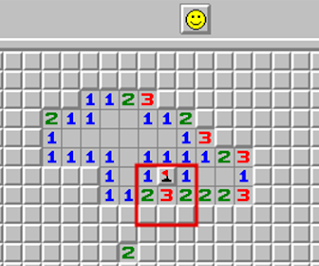You start to see patterns that come out frequently when you're playing mine-hunting games. It's kind of a formula. The more you know this pattern, the more helpful it is to shorten your record. Let's look at the most common 1-2-1 formula.
1-2-1 Pattern
The pattern that I use most often is 1-2-1. If 1-2-1 comes in a row or row in succession as shown below, there is a mine in place 1.
 |
| 1-2-1-pattern |
Two of the three unopened spaces are mines. If two mines are attached in a row, the number 1 cannot appear. In the end, the number of possible cases is one mine in 1 place.
If you don't understand it, you can flag mines one by one and count the number of cases.
So this is it? No, the application of this 1-2-1 formula is endless.
1-2-1 Pattern Application
The number in the figure below is 1-2-2. The most important thing here is the number two on the right. Right 2 is actually 1. Because you've already found one mine up there.
 |
| 1-2-1 Pattern Application |
Since 1-2-1 (2-1=1) satisfies the 1-2-1 formula, the location of the mines is as follows.
 |
Let's look at the next example. It's 2-3-2 and we've got a mine up there. If you calculate 1 (2-1=1)-2 (3-1=2)-1 (2-1=1) then it becomes 1-2-1. Do you know where the mines are?
 |
| 2-3-2-pattern |
Did you get it? It's the easiest and most frequent pattern, so if you know it, it'll help you shorten the record. Minesweeper has a basic formula in this way, and it's fun to apply them to different situations.
Subscribe My YouTube Channel
"파트너스 활동을 통해 일정액의 수수료를 제공받을 수 있습니다"
댓글
댓글 쓰기